|
Sara Schneckloth

|
|
Sara Schneckloth, 2013
|
at Soho20 and the
Fowler Arts Collective
In late June and early July of this year, Sara
Schneckloth, an artist currently working in South
Carolina who should be known better here (and in
the world) visited the Fowler Art Collective
in Greenpoint to do several days of intense work
(ten hours a day, according to the artist) on her
characteristic drawing. A few months previously
(in March) she had a brief show at Soho20 in Chelsea,
sharing the space with some other artists.
The first show was rather small, constrained by
the space available to it. (Real estate is always a
problem in the big city.) However, on the last day of
the show, Schneckloth gave a talk and answered some
questions about her work. Much of her talk was (to
me) gratifyingly technical as opposed to theoretical
or art-critical; I learned, for example,
that many of her drawings are now done on a kind
of plastic paper called Yupo. She also brought out
and unrolled some larger drawings hidden away in a
back room and displayed them on the floor, which was
about the only space available for them given their
size. The work shown at Soho20 was of what we might
call the 'cellular' or 'textural' variety, which I
expand upon below.

|
|
Sara Schneckloth, 2013
|
In the case of the Fowler Arts Collective, she was
invited to work in their environment in Greenpoint,
Brooklyn, which is housed in a loft or factory
down by the waterfront that once was supposedly
the site of the American Rope Company and other
such earnest old-time industries. Coffee and gold
were also once warehoused here; while some old beans
have been found, the gold seems to have been treated
somewhat more carefully. This loft contains various
spaces partially separated from one another by
plastic sheeting or other light partitioning, so they
might serve as a site for collective work, something
Schneckloth has participated in in the past, according
to her website. However, her efforts in
Greenpoint were entirely a solitary enterprise.
Her work is not easy for me to describe or analyze
at the same level I react to it, intuitively
and emotionally. On the one hand, it is mostly
non-representational, but as one observes it it
is clear that the forms Schneckloth is creating
as she draws are related to natural forms and
physical processes, rather than being confined
to gestures, geometrical figures, random markings,
or other figures, unrelated to the natural world, which
abstractionists have often been fond of in the past.
(Back in the day, saying 'This looks like...' to
one of the severer abstract artists could occasion
hostility or depression.)
One might well say, as with some other abstract
artists, that her work is nature, rather than
represents it. However, this statement has been
made about Abstraction Expressionism of the entirely
gestural sort (for example, Pollock) and may, therefore
misrepresent it; Schneckloth's has a lot in it besides
gesture.
Some of the other adjectives one might apply pretty
much across the board are organic, biotic, cellular,
spatial, fractal, motile, fluent, organic, visceral,
textural, tactile, kinetic. Indeed, some
of her works have been designed to actually move
physically and to invite interaction (in a fairly
controlled manner) with their audience, although
these were not part of the recent shows. (Check her
web site for these; there are videos.)
In fact, a considerable body of Schneckloth's work
can be seen on her web site, going back several years;
I can't help but mention the large drawing currently
(September 20, 2013) on the front page of her web site,
although nothing very much like it was in either of
the shows. I will contend instead that principles
or concepts underlying the more current work appear
in it as well.
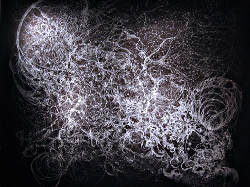
|
|
Sara Schneckloth, 2013
|
We observe that this drawing consists to a large
extent of circular, spiral, helical, or otherwise
loopy traces. These are not of the same size;
instead, small ones appear to grow out of big
ones, and vice versa, much as we observe in the
form of growing plants, waves in the water, and
other natural phenomena. One is reminded as well
of the Mandelbrot figure, and, perhaps a bit more
remotely, of the wide blank spaces juxtaposed to
small detail in some Beardsley drawings. The effect
is to give the work a strong sense of depth,
which, however, unlike perspective, is not
illusional; the depth, as with fractal figures,
is actually present, because it is a depth of
detail rather than of feigned, illusional distance.
One might see the whole of this particular drawing as
the image of a brain or nervous system, or rather the
trace of energies passing within it, somehow become
visible. Other drawings along these lines remind
me of the similar networks made by vines, leaves,
mycelia, and other natural biotic forms which follow
the same organizational patterns as nervous systems
and the currents within them.
The sense of motion, that is, of repeated change in
time, generated by the circular and spiral traces
of the drawing, adds another dimension to the image.
This may touch upon the sense of remembering
which Schneckloth alludes to in her titles and writing
(for example, 'Haptic Recall', that is, memory based
on the sense of touch and proprioception).
Much as I would like to go on about many other
examples of Schneckloth's past work, we must move
along to the present.
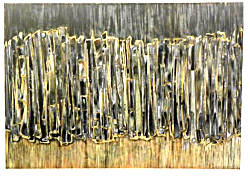
|
|
Sara Schneckloth, 2013
|
In these more recent works that appeared in the two
shows, Schneckloth's emphasis changes from looping to
more solid, although living, structures. One thinks
of cells, tissues, seeds, stones, walls, buildings;
even urbanization. She worked not only at imitating
stone walls in some of her drawing but of actually
building one, a serious wall whose construction
was overseen by an expert and is intended to last
for 200 years.
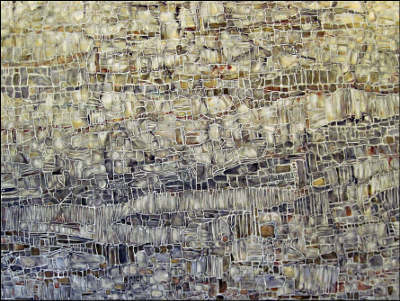
|
|
Sara Schneckloth, 2013
|
One reviewer remarked that some of her
most recent work in Greenpoint somewhat resembled the
modest low-rise architectures of this once-humble
industrial and residential district of New York City,
which of course have a rather cellular or layered form
when see from a rooftop: panes, windows, rooms, roofs,
houses, streets, the river, the horizon. One doesn't
often think of the streets and houses of Greenpoint
imitating the cellular structure of a living being,
but of course they do because, in a sense, that's
what they are, at least until they're replaced by
the sterile prisms of upscale high-rise condos.

|
|
Sara Schneckloth, 2013
|
However, to me the forms were more geological or
tectonic, and a different form of motion and tactile
sense is present, hard, slower, and achieving higher
pressure, so to speak. Instead of sweeping the viewer
into a moving orbit, they require concentration and
contemplation of internal tensions.
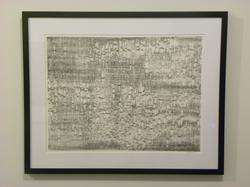
|
|
Sara Schneckloth, 2013
|
Besides these drawings several of the drawings in
the March show were called 'Deep Sequencing'. This
is a a method of analyzing DNA and RNA, and the
drawings resembled the charts which are produced by
the machinery which is currently used to sequence
(that is, discover the composition and structure of)
genetic material. As it happens they also resembled
(for me) the sound frequency charts made and used by
linguists to analyze language production. The DNA
sequence is, of course, a 'language' in that it
contains sequences of symbols which have a kind
of grammar. This rather philosophically advanced
work may have been somewhat esoteric for those not
familiar with the technologies. They might be seen
as a trace of meditative study.
The remainder of the work at this show fell into
what I call the geological category: the drawings
seem to depict (or to be) layers of some kind of
regularly split rock or other hard mineral, perhaps
interspersed with metals or liquids. (Indeed, some
of the drawings include metallic inks.) The drawing
is generally multilayered, not only along the plane
of the medium but in successive overlays toward the
viewer, which gives in a sculptural sense.
It should be mentioned here that the medium used in
these drawings is the aforesaid Yupo. It's possible
that they could not have been made without it, since
repeated overdrawing, at least in my experience, often
leads to a physical breakdown of the underlying media,
and in the case of inks and watercolors, they may
break down as well due to repeated wetting, or permit
the pigments to spread randomly outward. (Of course,
some people like this effect -- but I don't think it
would have been relevant to the work at hand.)
Yupo is something like Mylar, but unlike Mylar it
does not reject water (or graphite or some kinds of
crayon), and it does seem to hang on to the pigments
that are laid down on it; they don't fall or wear
off too easily. On the other hand, you can generally
wash off a piece of Yupo and start over, which could
be seen as either an advantage or a defect. It also
requires some getting used to; it doesn't work the
way paper or fabrics do.
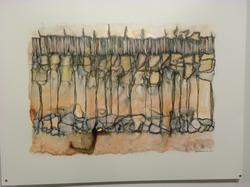
|
|
Sara Schneckloth, 2013
|
At the Fowler exhibition, the 'geological' style
prevailed as well, although in some of the drawings
one sees other forms, of roots or tendrils, maybe,
emanating from the closely packed rectangular cells
or blocks. There is also a
different kind of flow in many of these drawings, created by the
spaces between the 'cells' and sometimes the 'cells'
themselves. As a result, some of the drawings look
very much like maps of urban territory, which one
might refer to the locus of their creation.
Another element present in some of the work was
the fractal dimensionality mentioned above, which
again gives the drawings depth not produced by
perspective. Most of them also have a strongly
textural appearance and, although flat, give a sort
of bas-relief effect. I think this may be one of
the areas where the Yupo medium is particularly
supportive, since it can sustain heavy overdrawing
or inking, thus allowing the artist to build up
an opaque painted or sculpted effect.
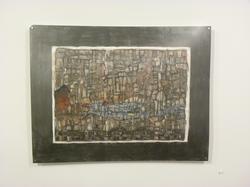
|
|
Sara Schneckloth, 2013
|
There is also a use of color which might
imply temperature or pressure, a new dimension for
the work in this style. It looks, then, as if the current
cellular or tectonic phase may be evolving into
something new, of which the color and the tendrils
could be the first harbingers. Artists have seasons,
too.

|
|
Sara Schneckloth, 2013
|
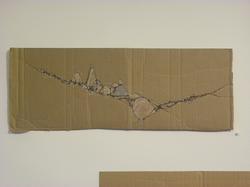
|
|
Sara Schneckloth, 2013
|

|
|
Sara Schneckloth, 2013
|
Schneckloth also made some small drawings on
cardboard while she was waiting for her materials
to arrive (this took a few days) which she chose to
put in the show. These are quite different from
the 'geological' drawings, although one might say
some of them have a form similar to collections of rounded
stones, maybe resting in a field. However, their
forms actually emanate from the folds and creases in
the cardboard, which begin with a branching, biotic
rather than a crystalline pattern and, so to speak,
bubble outward from the base line. One exception
to this rule is a drawing in which the base line (a
fold in the material) is avoided by the drawn forms, which
might be said to dance around it with each other,
much as the molecules spiral around each other in
the double helix of DNA. Maybe we are back to
'Deep Sequencing'!
Unfortunately this show lasted for only one day,
so that I was not able to give the all works the
extended study they deserved. But we have the
web site to look at.

|
|
Fowler Arts Collective; The artist is at the left.
|
Links
|
